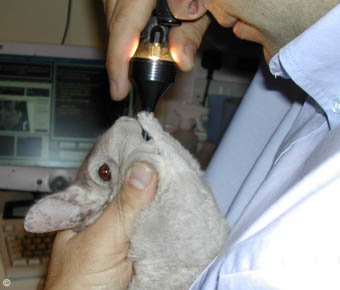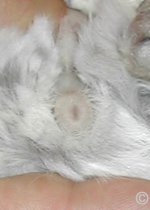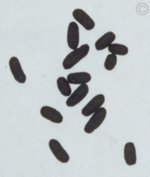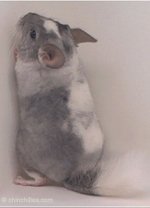 Examining a chinchilla may not seem important to some owners especially if the chinchilla is looking well and healthy but there are valid reasons why you must examine a chinchilla on a regular basis.
Examining a chinchilla may not seem important to some owners especially if the chinchilla is looking well and healthy but there are valid reasons why you must examine a chinchilla on a regular basis.
Without regularly holding and examining a chinchilla you will not know if any differences are beginning to expose themselves making it impossible to spot the signs of an underlying illness much sooner and making the ailment a lot easier to cure.
Chinchillas go down hill rapidly when ill and generally do not expose any symptoms until the ailment is in the mid-latter stages, which sometimes proves impossible to cure. Regular examinations will expose a disorder sooner and a chinchilla will have a better chance at survival and will not be subjected to such intense medication.
Examining a chinchilla also helps the bonding process between the two of you and also gets the chinchilla used to being held and examined. You will also become aware of what a healthy chinchilla should look and feel like.
All areas of a chinchilla will need to be examined and you should start as soon as you buy a chinchilla. Examine the chinchilla you are thinking of buying before you commit and when you take the chinchilla home, it is recommended you get an initial overall examination by a professional veterinary surgeon.
Once your chinchilla has had the professional 'all-clear' keep up regular examinations on a weekly basis by checking the following areas:
 Eyes
Eyes
Healthy chinchillas have bright, sparkly, clear and dry eyes with the surrounding fur dry and unmated. Under examination, if you see signs of weeping, stickiness, scabs or redness then the chinchilla has an underlying health issue. The ailment can be serious such as malocclusion or another tooth disorder, which will need immediate veterinary attention. Eye infections are common in chinchillas as is conjunctivitis. All eye issues will need veterinary input for a course of antibiotics and bathing in saline solution until the problem is cleared. No dustbaths should be offered to any chinchilla with weeping eyes as dust will clog around the eye area making the problem worse.
Ears
 Due to their size, chinchilla ears are relatively easy to examine and are also the first place to be attacked in fighting chinchillas. As chinchillas do not sweat, they expel heat through their ears (as well as feet and paws) making this one of the first places to expose high body temperatures and ill health. The ears should be dry with no signs of weeping or no cuts and lacerations present. A chinchilla that frequently paws at its ear is expressing an underlying illness that will need further examination by a professional. Pigmentation spots (dark mole-like spots) may occur especially in chinchillas with the beige gene but this is nothing to worry about. Dry flaky ears can be common due to over dustbathing and to compensate you can rub a tiny amount of Unscented Neutrogena Hand Cream into the area, which will hydrate the area over night.
Due to their size, chinchilla ears are relatively easy to examine and are also the first place to be attacked in fighting chinchillas. As chinchillas do not sweat, they expel heat through their ears (as well as feet and paws) making this one of the first places to expose high body temperatures and ill health. The ears should be dry with no signs of weeping or no cuts and lacerations present. A chinchilla that frequently paws at its ear is expressing an underlying illness that will need further examination by a professional. Pigmentation spots (dark mole-like spots) may occur especially in chinchillas with the beige gene but this is nothing to worry about. Dry flaky ears can be common due to over dustbathing and to compensate you can rub a tiny amount of Unscented Neutrogena Hand Cream into the area, which will hydrate the area over night.
Nose
 A chinchilla's nose should be dry and clean with no discharge, cuts or lacerations. Under examination, a red, dry, flaky or inflamed nose can be symptoms of a fungal infection, this will be further expressed with patches of lost skin around the area and a chinchilla will be constantly itching. Wheezing or discharge from the nose can indicate a serious respiratory issue. Chinchillas can get colds like humans and you will need to make sure they are kept warm, hydrated and unstressed during this period of sickness.
A chinchilla's nose should be dry and clean with no discharge, cuts or lacerations. Under examination, a red, dry, flaky or inflamed nose can be symptoms of a fungal infection, this will be further expressed with patches of lost skin around the area and a chinchilla will be constantly itching. Wheezing or discharge from the nose can indicate a serious respiratory issue. Chinchillas can get colds like humans and you will need to make sure they are kept warm, hydrated and unstressed during this period of sickness.
Mouth
Any signs of wetness around the mouth area or pawing at the mouth will generally mean there is a tooth issue that needs immediate veterinary intervention. When examining a chinchilla, the mouth area should be dry and closed. A chinchilla that does not close its mouth properly will be experiencing 'open bite' where the back molars have overgrown  and are preventing the chinchilla from closing its mouth properly.
and are preventing the chinchilla from closing its mouth properly.
Teeth
Tooth issues are a serious condition in chinchillas and can prove fatal if not addressed soon enough. It is imperative that you examine chinchilla teeth regularly by lifting up the front gum to expose the colour. Chinchilla teeth should be dark orange and anything less than this (light orange, yellow or white) will indicate a calcium deficiency. Chinchillas have 20 teeth (16 molars and 4 incisors) that should be straight, uncurled and unchipped. The top teeth should sit in front of the lower teeth and no tooth should be missing.
Feet & Paws
 Chinchillas have 3 toes and 4 flexible digits for fingers and a thumb (which is severely underdeveloped but can hold and grasp food or even your finger). The area is padded for extra protection and should show no cuts, sores or scabs. Chinchillas suffer from a painful condition called Bumblefoot, which happens when chinchillas do not have something soft to rest on. Chinchillas that only have wired flooring and hard wooden shelving will expose sore feet with scabs forming. Always ensure something soft is within the cage for a chinchilla to relax on and if needs be moisturize the chinchilla's feet with a tiny amount of Unscented Neutrogena Hand Cream rubbed well in.
Chinchillas have 3 toes and 4 flexible digits for fingers and a thumb (which is severely underdeveloped but can hold and grasp food or even your finger). The area is padded for extra protection and should show no cuts, sores or scabs. Chinchillas suffer from a painful condition called Bumblefoot, which happens when chinchillas do not have something soft to rest on. Chinchillas that only have wired flooring and hard wooden shelving will expose sore feet with scabs forming. Always ensure something soft is within the cage for a chinchilla to relax on and if needs be moisturize the chinchilla's feet with a tiny amount of Unscented Neutrogena Hand Cream rubbed well in.
Anus
 Not so pleasant but it still needs examining! The area around a chinchilla's anus should be clean and dry. If you detect wetness or stained fur a chinchilla will be suffering from diarrhoea or maybe a urinary tract infection.
Not so pleasant but it still needs examining! The area around a chinchilla's anus should be clean and dry. If you detect wetness or stained fur a chinchilla will be suffering from diarrhoea or maybe a urinary tract infection.
Urine
The colour of chinchilla's urine (should be examined regularly) and will depend on how much they drink and whether there are any underlying health issues. The normal colour of chinchilla urine is yellow but chinchillas that are fed alfalfa can commonly be dark orange-brown. If you have a wired bottom cage that is lined with newspaper, for example, you may notice white powdery patches within the chinchilla's urine, this indicates excessive calcium excretion as 2% of calcium is lost via the chinchilla's urine and 75% excreted in the faeces. Dark brown to red urine will indicate an intestinal disease that needs immediate medical attention.
 Droppings/Faeces
Droppings/Faeces
The best way to examine faeces is to actually pick one up. There are plenty to choose from as chinchillas drop approximately 200 faeces per day. When examining chinchilla droppings they are odorless and should be dark brown in colour but this can vary depending on what the chinchilla is being fed. Droppings should be oval or rounded in shape, plump, slightly moist and unslimmy. When broken open a healthy faeces will have a solid consistency throughout. Holey droppings can be a sign of digestive problems and droppings with evident strands of hay will indicate a tooth issue. Any squishy droppings or faeces stuck to the chinchilla's fur will be a clear indication of diarrhoea and long, pointy, brittle faeces is a symptom of constipation.
Genitals
 Both the male and female genitals need examining for different reasons. A male chinchilla is susceptible to 'hair ring' especially during the mating season and will need examination on a weekly basis. You will notice if a male has a potential hair ring as he will constantly be attending this region. When examining the male's penis, you will need to ensure the shaft completely retracts into the foreskin. If this isn't the case, you will need to look for a hair ring by gently pulling the chinchilla's foreskin completely back and examining for strands of hair, which will be wrapped around the shaft. This is a fatal condition to a male and if spotted, it must be removed immediately! This is done by gently easing the hair off the shaft with the use of gentle persuasion and lubrication. A female genitals must be examined and should be clean and dry - any discharge from both the male and female can indicate an Urinary Tract Infection (amongst other ailments), which will need immediate medical attention. Any noticeable blood around a female's genitals can indicate a miscarriage, which will need investigating by a qualified veterinary surgeon.
Both the male and female genitals need examining for different reasons. A male chinchilla is susceptible to 'hair ring' especially during the mating season and will need examination on a weekly basis. You will notice if a male has a potential hair ring as he will constantly be attending this region. When examining the male's penis, you will need to ensure the shaft completely retracts into the foreskin. If this isn't the case, you will need to look for a hair ring by gently pulling the chinchilla's foreskin completely back and examining for strands of hair, which will be wrapped around the shaft. This is a fatal condition to a male and if spotted, it must be removed immediately! This is done by gently easing the hair off the shaft with the use of gentle persuasion and lubrication. A female genitals must be examined and should be clean and dry - any discharge from both the male and female can indicate an Urinary Tract Infection (amongst other ailments), which will need immediate medical attention. Any noticeable blood around a female's genitals can indicate a miscarriage, which will need investigating by a qualified veterinary surgeon.
 Fur
Fur
Chinchilla fur is easy to examine and should be smooth, clean, untangled, dry and of even length (approximately 1") all over. Under examination shorter patches of fur can indicate a fur chewer and lost patches of fur with inflamed skin exposure, can indicate a fungal infection. Any matted fur around the chinchilla's hind legs indicate a serious tooth issue that needs immediate investigation and any wet fur around the mouth or anus will indicate underlying health issues.
Weight
 A chinchilla should feel firm and compact. Chinchilla kits weigh between 35 - 60 grams and increase at a weight of 5-10 grams per week. An adult male chinchilla generally weighs 400 - 600 grams and females heavier at 500 - 700 grams. Chinchillas hide any illness/disease very well but their weight will be the first thing effected. It is therefore vitally important to weight chinchillas on a weekly basis and keep a record. Any differences of 20 grams within one week should be noted and a chinchilla taken to a vet for a full professional examination...remember, prevention in chinchillas is much easier than trying to find a cure!
A chinchilla should feel firm and compact. Chinchilla kits weigh between 35 - 60 grams and increase at a weight of 5-10 grams per week. An adult male chinchilla generally weighs 400 - 600 grams and females heavier at 500 - 700 grams. Chinchillas hide any illness/disease very well but their weight will be the first thing effected. It is therefore vitally important to weight chinchillas on a weekly basis and keep a record. Any differences of 20 grams within one week should be noted and a chinchilla taken to a vet for a full professional examination...remember, prevention in chinchillas is much easier than trying to find a cure!
The Chinchilla A-Z Health & Sickness Bible is just that, a complete Bible of illnesses and diseases listed alphabetically from A to Z. This amazing ebook lists over 150+ illnesses and diseases to look out for and offers preventative advice and what 'cure' there is for a specific ailment. This is a 'must-have' book for any caring chinchilla owner arming them will all the information they will ever need about a specific ailment.
Read More...



 Examining a chinchilla may not seem important to some owners especially if the chinchilla is looking well and healthy but there are valid reasons why you must examine a chinchilla on a regular basis.
Examining a chinchilla may not seem important to some owners especially if the chinchilla is looking well and healthy but there are valid reasons why you must examine a chinchilla on a regular basis.

 A chinchilla's nose should be dry and clean with no discharge, cuts or lacerations. Under examination, a red, dry, flaky or inflamed nose can be symptoms of a fungal infection, this will be further expressed with patches of lost skin around the area and a chinchilla will be constantly itching. Wheezing or discharge from the nose can indicate a serious respiratory issue. Chinchillas can get colds like humans and you will need to make sure they are kept warm, hydrated and unstressed during this period of sickness.
A chinchilla's nose should be dry and clean with no discharge, cuts or lacerations. Under examination, a red, dry, flaky or inflamed nose can be symptoms of a fungal infection, this will be further expressed with patches of lost skin around the area and a chinchilla will be constantly itching. Wheezing or discharge from the nose can indicate a serious respiratory issue. Chinchillas can get colds like humans and you will need to make sure they are kept warm, hydrated and unstressed during this period of sickness.
 Chinchillas have 3 toes and 4 flexible digits for fingers and a thumb (which is severely underdeveloped but can hold and grasp food or even your finger). The area is padded for extra protection and should show no cuts, sores or scabs. Chinchillas suffer from a painful condition called Bumblefoot, which happens when chinchillas do not have something soft to rest on. Chinchillas that only have wired flooring and hard wooden shelving will expose sore feet with scabs forming. Always ensure something soft is within the cage for a chinchilla to relax on and if needs be moisturize the chinchilla's feet with a tiny amount of Unscented Neutrogena Hand Cream rubbed well in.
Chinchillas have 3 toes and 4 flexible digits for fingers and a thumb (which is severely underdeveloped but can hold and grasp food or even your finger). The area is padded for extra protection and should show no cuts, sores or scabs. Chinchillas suffer from a painful condition called Bumblefoot, which happens when chinchillas do not have something soft to rest on. Chinchillas that only have wired flooring and hard wooden shelving will expose sore feet with scabs forming. Always ensure something soft is within the cage for a chinchilla to relax on and if needs be moisturize the chinchilla's feet with a tiny amount of Unscented Neutrogena Hand Cream rubbed well in.

 Both the male and female genitals need examining for different reasons. A male chinchilla is susceptible to 'hair ring' especially during the mating season and will need examination on a weekly basis. You will notice if a male has a potential hair ring as he will constantly be attending this region. When examining the male's penis, you will need to ensure the shaft completely retracts into the foreskin. If this isn't the case, you will need to look for a hair ring by gently pulling the chinchilla's foreskin completely back and examining for strands of hair, which will be wrapped around the shaft. This is a fatal condition to a male and if spotted, it must be removed immediately! This is done by gently easing the hair off the shaft with the use of gentle persuasion and lubrication. A female genitals must be examined and should be clean and dry - any discharge from both the male and female can indicate an Urinary Tract Infection (amongst other ailments), which will need immediate medical attention. Any noticeable blood around a female's genitals can indicate a miscarriage, which will need investigating by a qualified veterinary surgeon.
Both the male and female genitals need examining for different reasons. A male chinchilla is susceptible to 'hair ring' especially during the mating season and will need examination on a weekly basis. You will notice if a male has a potential hair ring as he will constantly be attending this region. When examining the male's penis, you will need to ensure the shaft completely retracts into the foreskin. If this isn't the case, you will need to look for a hair ring by gently pulling the chinchilla's foreskin completely back and examining for strands of hair, which will be wrapped around the shaft. This is a fatal condition to a male and if spotted, it must be removed immediately! This is done by gently easing the hair off the shaft with the use of gentle persuasion and lubrication. A female genitals must be examined and should be clean and dry - any discharge from both the male and female can indicate an Urinary Tract Infection (amongst other ailments), which will need immediate medical attention. Any noticeable blood around a female's genitals can indicate a miscarriage, which will need investigating by a qualified veterinary surgeon.
 A chinchilla should feel firm and compact. Chinchilla kits weigh between 35 - 60 grams and increase at a weight of 5-10 grams per week. An adult male chinchilla generally weighs 400 - 600 grams and females heavier at 500 - 700 grams. Chinchillas hide any illness/disease very well but their weight will be the first thing effected. It is therefore vitally important to weight chinchillas on a weekly basis and keep a record. Any differences of 20 grams within one week should be noted and a chinchilla taken to a vet for a full professional examination...remember, prevention in chinchillas is much easier than trying to find a cure!
A chinchilla should feel firm and compact. Chinchilla kits weigh between 35 - 60 grams and increase at a weight of 5-10 grams per week. An adult male chinchilla generally weighs 400 - 600 grams and females heavier at 500 - 700 grams. Chinchillas hide any illness/disease very well but their weight will be the first thing effected. It is therefore vitally important to weight chinchillas on a weekly basis and keep a record. Any differences of 20 grams within one week should be noted and a chinchilla taken to a vet for a full professional examination...remember, prevention in chinchillas is much easier than trying to find a cure!